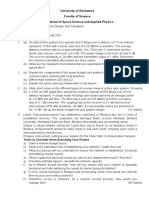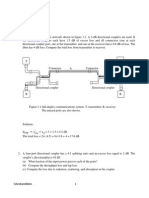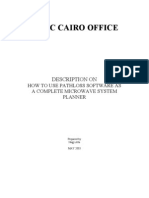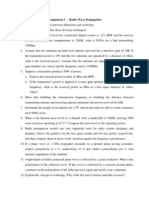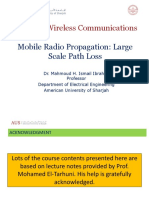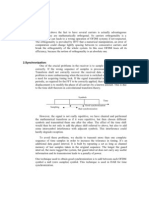PathLOS Satelite
PathLOS Satelite
Uploaded by
rakasiwi2013Copyright:
Available Formats
PathLOS Satelite
PathLOS Satelite
Uploaded by
rakasiwi2013Copyright
Available Formats
Share this document
Did you find this document useful?
Is this content inappropriate?
Copyright:
Available Formats
PathLOS Satelite
PathLOS Satelite
Uploaded by
rakasiwi2013Copyright:
Available Formats
LINK BUDGET UNTUK SATELITE
1. Calculation of Uplink path loss 1. Up link frequency Up link frequency is frequency at which Ground Station is communicating with Satellite. For C band up link frequency is in the order of 6 G Hz 2. Up link path loss Up link path loss depend on up link frequency & distance between satellite and ground station Up-link path loss=10 log(4dC/f)2(dB)[1] Here d is the distance between satellite & ground station f is the frequency; C is the velocity of light Example: Distance between satellite & earth station is d= 37,000 Km Up link frequency f= 6.175 G Hz uplink loss or free space loss = 10 log(4 *37000*C/f)2 = 20 log(4*37000*C/f) = 20log(4* *37000*3*108/f) = 199.61 dB
2. Calculation of Transmit antenna gain 1. Antenna diameter Diameter of parabolic reflector antenna is referred as antenna diameter. It is denoted by D 2. Antenna efficiency Antenna efficiency is the ratio of input power to the radiated power of the antenna. It is denoted by . The value of lice between 0.55 to 0.73 3. Antenna gain GT The isotropic power gain of the antenna, G T, is defined as the power density in the maximum direction, denoted here by P D , to the power density archived by a 100% efficient isotropic radiator.
Thus
GT=PD/(PT/4) PT is the total power radiated. Antenna gain in GT = 10 log (2D2/(2*100)) = 10 log (2D2/((C/f)2*100)) = 10 log (2D2/((3/10*f)2*100)) = 10 log (2D2/(3/f)2)(dB)..[2]
Example Calculation of the gain of a 3.80-m parabolaidal antenna operating frequency of 6.175 G Hz & aperture efficiency of 0.55 GT = 10 log (2D2/(3/f)2) Hence GT = 45.21 dB
3. Calculation of Transmit EIRP (in dB W)&operating FD 1. Transmit power per carrier It is the power given to the antenna at the Earth station to radiate power. Its range lice in the watts. 2. Transmitter feeder loss Losses will occur in the connection between the transmitting antenna and the transmitter proper. Such losses will occur in the connecting wave-guides, filters and couplers. 3. Antenna pointing loss When a satellite link is established, the ideal situation is to have the earth station and satellite antennas aligned for maximum gain. There are two possible sources of off axis loss , one at the satellite and one at the earth station . The off axis loss at the satellite is taken in to account by designing the link for operation on actual satellite antenna contour. The off axis losses at the earth station is referred to as the antenna pointing loss. Antenna pointing losses are usually only a few tenths of a decibel. 4. No of carriers By frequency multiplexing scheme we can transmit any number of carriers through an antenna. 5. Transmit EIRP This is the product of actual power given to transmitting antenna and antenna power gain of transmitting antenna. That the equivalent isotropic power (EIRP) may be defined as EIRP=P TGT EIRP is often expressed in decibels relative to 1 watt, or dBW. Let P t be in Watts then EIRP = [PT]+[GT] dBW If we consider transmitter feeder loss & antenna pointing loss in to account Transmitter EIRP= 10 log (Transmitter power per carrier )-Transmitter Feeder loss + Transmitter antenna gain antenna pointing loss (dbW)..[3]
Example : Calculation of transmit EIRP for an antenna having the following data. Transmit power per carrier- 0.28 W, antenna feeder loss-1.00 dB, antenna pointing loss-0.70 dB And transmitter antenna gain 45.21dB. Solution Transmit EIRP = 10 log (0.28)-1 + 45.21- 0.70 = 37.98 dB 6. Satellite operating flux density (dB /Sq m) The traveling tube amplifier in a satellite transponder exhibits power output saturation. The flux density required in the receiving antenna to produce saturation of the TWTA is termed the saturation flux density. Satellite operating flux density = Transmitter EIRP Up link Rain attenuation 162.2 (dB /Sq m).[4] Example : calculate satellite operating flux density (dB /Sq m)for the satellite having EIRP 37.98 dB and no rain attenuation . Solution Satellite operating flux density dB/Sq m = 37.98- 162.2 = -124.21 dB/Sq m 7. Amplifier back off To reduce inter-modulation distortion, the operating point of the TWT must be shifted to the linear portion of the curve, the reduction in input power being referred as input back off. When multiple carriers present, the power around saturation, for any carrier, is somewhat less than the achieved with single carrier operation. The input back-off is the difference in decibels between the carrier input at the operating point, and saturation input that would be required for single carrier operation. 8. Power rating of ground transmitter It the power delivered by the ground transmitter. Power rating of ground transmitter can be expressed as Power rating of ground transmitter =10((10 log (Number of carriers * Power per carrier)+amplifier backoff)/10) .[5]
Example : calculate power rating of ground transmitter operating at following conditions. Number of carriers- 1, Power per carrier- 0.28 W, Amplifier back off0 dB. Solution Power rating of ground transmitter = 10((10 log (Number of carriers * Power per carrier)+amplifier backoff)/10) = 0.28 W
4.Calculation of uplink to noise ratio 1. Up link rain attenuation (dB) Rain fall results in attenuation of radio waves by scattering , and by absorption , of energy from the wave. Rain attenuation increases with increasing frequency and in worse at Ku band compared to C band. Studies have shown that the rain attenuation for horizontal polarization is considerably greater than for vertical polarization. 2. Satellite G/T (dB/k) G/T ratio indicates figure of merit. G/T ratio is the ratio of gain of the satellite to the thermal noise temperature of the satellite. G/T ratio depends on the satellite components. 3. Uplink C/No(dB Hz) The up link of a satellite circuit is the link in which the earth station is transmitting the signal and the satellite is receiving it . Carrier to noise ratio of up link is given as [C/No]U = [EIRP]U + [G/T]U - [losses] U + 228.6 =Transmitter EIRP- (Up link path losses + Up link rain attenuation) + Satellite G/T + 228.6(dB)..[6] Example : calculate power rating of ground transmitter operating at following conditions Transmitter EIRP37.97 dB W, Up link rain attenuation-0.0 dB, Up link path loss 199.62 dB, satellite G/T(dB/K)-5.00 Solution : [C/No]U = 37.97 5.00-199.92+228.6 = 61.65 dB 5.Calculation of satellite operating down link EIRP 1. Saturated EIRP (dB W) It is the EIRP of the satellite, at which ground station amplifier goes in to saturation. 2. Operating flux density (dB /Sq m) The traveling tube amplifier in a Earth station transponder exhibits power output saturation. The flux density required in the receiving antenna to produce saturation of the TWTA is termed the saturation flux density. 3. Amplifier back off To reduce inter-modulation distortion, the operating point of the TWT must be shifted to the linear portion of the curve from nonlinear portion, the reduction in input power being referred as input back off. When
multiple carriers present, the power around saturation, for any carrier, is somewhat less than the achieved with single carrier operation. The input back-off is the difference in decibels between the carrier input at the operating point, and saturation input that would be required for single carrier operation. 4. Output back off Where in put back off is employed corresponding output back off must be allowed for the satellite EIRP. 5. Satellite operating downlink EIRP(dB W) Satellite operating down link EIRP can be calculated as follows Satellite operating downlink EIRP(dB W)= Satellite operating flux density + ((Saturated EIRP Output back-off )-(Saturation flux density Input back-off)) [7] Example Calculate satellite operating downlink EIRP (dB W) for the satellite operating flux dencity-124.23 dB satellite EIRP 32 dB out put back off 6 dB saturation flux density 83 dB input back off 9 dB Satellite downlink EIRP(dB W) = -124.23 + (( 32 6 ) (-83 - 9 )) = - 6.23 6.calculation of satellite operating band width 1. In put data rate (Kb/s) It is the number of actual message signals per second. 2. Link overhead factor (% Worst case) It represents additional transmitting delay between message bits to avoid collision or inter-symbol interference of message bits. 3. FEC rate coding Forward error correction technique enables the receiver to both Detect and correct errors without needing to inform the transmitter 4. Bits/Symbol (m) It is defined as the number of symbols transmitted by the transmitter per bit 5. Effective in put data rate (kbps) Effective in put data rate (kbps) can be calculated by the formula Effective input data rate = Input data rate(kbps)/(1+Link over head factor/100) .[8] Example: Calculate effective input data rate (kb/s) for a satellite input data rate 9.6 K B/S. And link overhead factor 0 %. Effective in put data rate = Input data rate (K B/S)/(1+ link overhead factor/100)
= 9.6/(1+0/100)= 9.6 KB/S
6. Transmission rate(kbps) Transmission rate = In put data rate / F E C rate coding [9] Example: Calculate transmission rate (kb/s) for a satellite input data rate 9.6 K B/S. FEC coding 0.50 . Solution: Transmission rate = In put data rate/FEC coding = 9.6/0.5=19.2 k B/S 7. Satellite operating band-width (kbps) per carrier Satellite operating band width (kbps) per carrier = (Transmission rate/Bits per symbol)*1.4 [10] Example: calculate satellite operating band-width(kbps)per carrier for the satellite transmission rate 19.2 bits per symbol =2 Satellite operating band width (kbps) per carrier = (Transmission rate/Bits per symbol)*1.4 =(19.2/2)*1.4=13.44 kB/S 7.Calculation of Downlink path loss 1. Down Link frequency Down link frequency is frequency at which satellite is communicating with ground station. For C band up link frequency is in the order of 4 G Hz , 12 G Hz for Ku band. 2. Downlink path loss Down link path loss depend on up link frequency & distance between satellite and ground station. Down link loss = 10 log(4d/(C/f))2 Here d is the distance between satellite & ground station f is the frequency of the down link wave C is the velocity of the light = 3 x108 m/Sec Down link loss = 20 log 4d/(3/10*f)(dB) Here f is in Giga hertz
[11]
Example : calculate downlink path loss for the satellite located 37000 km far from the earth station and operating 3,950 GHz frequency Down link loss = 20 log (4 d/(3/10*f) = 195.73 dB
8. Calculation of receiver antenna gain 1. Antenna diameter Diameter of parabolic reflector antenna is referred as antenna diameter. It is denoted by D. 2. Antenna efficiency Antenna efficiency is the ratio of input power to the radiated power of the antenna. It is denoted by . The value of lice between 0.55 to 0.73. 3. Antenna gain GR The isotropic power gain of the antenna, GT, is defined as the power density in the maximum direction, denoted here by P D , to the power density archived by a 100% efficient isotropic radiator. Thus GR = PD/(PT/4) PT is the total power radiated. Antenna gain in GR (dB) = 10 log (2D2/(2*100)) = 10 log (2D2/((C/f)2*100)) =10 log (2D2/((3/10*f)2*100)) =10 log (2D2/(3/f)2)(dB)..[12] Example Calculation of the gain of a 3.8-m parabolaidal antenna operating frequency of 3.95G Hz & aperture efficiency of 0.55 GR = 10 log (2D2/(3/f)2) = 41.33 dB 9. Calculation of receiver G/T 1. Antenna elevation angle (deg) Antenna elevation effects the antenna noise temperature. Antenna noise temperature decreases with increase of elevation. 2. Antenna noise temp Antenna noise temperature is the sum of all noise sources at the antenna. 3. Increase in Antenna noise due to rain Rain effects the antenna noise temperature. It increases the antenna noise temperature. 5. LNA noise temp LNA means Low Noise Amplifier. LNA noise temperature means noise temperature of LNA.
6. System noise temp (k) receiving antenna
It is the sum of all noise temperatures at the
System noise temperature (k) = antenna noise temperature + increase in antenna noise due to rain + LNA noise temperature (k) [13]
Example: Calculate system noise temperature of a satellite having noise temperature 25 K increase in antenna noise due to rain =0 K LNA noise temperature = 50 K Solution : System noise temperature = antenna noise temperature + increase in antenna noise due to rain + LNA noise temperature = 25 + 0 + 50 = 75 7. Receiver G/T (dB/ k) Receiver G/T is the Figure of merit at the receiver antenna. Receiver G/T (dB/K) = Receiver Antenna gain 10 log(system noise temperature) (dB/k).[14] Example: Calculate Receiver G/T (dB/K) of a satellite having antenna gain 41.33 , over all receiver noise temperature = 75 K Receiver G/T (dB/K) = Receiver Antenna gain 10 log(system noise temperature) = 41.33- 10 log(75) =22.579 (dB/K) 10. Calculation of link margin 1. Down link rain attenuation Rain fall introduces attenuation by absorption and scattering of signal energy, and the absorptive attenuation introduces noise. Effective noise temp of rain as Train = TA(1-(1/A)) Where TA is known as apparent absorber temperature. It is a measured parameter, which is a function of many factors, including physical temperature of rain, and scattering effect of the rain, and the scattering effect of the cell on the thermal noise incident up on it. The value of the apparent absorber temperature lies between 270 and 290 K . Total sky noise temperature is the clear sky temperature plus the rain temperature TSky= Tcs+TRAIN Where TCs is the clear-sky noise temperature
2. Receiver antenna pointing loss When a satellite link is established, the ideal situation is to have the earth station and satellite antennas aligned for maximum gain. There are two possible sources of off axis loss , one at the satellite and one at the earth station . The off axis loss at the satellite is taken in to account by designing the link for operation on actual satellite antenna contour. The off axis losses at the earth station is referred to as the antenna pointing loss. Antenna pointing losses are usually only a few tenths of a decibel. 3. Eb/No required for BER of 1/ 107 It is Signal to noise ratio required to achieve Bit Error Ratio of 1 error bit per 107 message bits. 4. Down link C/No (dB Hz) calculated as follows. It is the down link carrier to noise ratio. It can be
Down link C/No(dB Hz) = Satellite operating EIRP - Downlink path loss - Down link rain attenuation - Receiving antenna pointing loss + Receiver G/T +228.6 .[15] Example : Calculate Down link C/No(dB Hz) for the Satellite operating EIRP = -6.23 dB W, Downlink path loss = 195.74 dB, Down link rain attenuation = 0 dB, Receiving antenna pointing loss = 0.70 dB, Receiver G/T = 22.58 (dB/K) Solution : Down link C/No(dB Hz) = Satellite operating EIRP - Downlink path loss - Down link rain attenuation - Receiving antenna pointing loss + Receiver G/T +228.6. = -6.23-195.74-0-0.70+22.58+228.6 = 48.51 dB Hz 5. Over all Down link C/No (dB Hz) It is the some of carrier to noise ratio at the down link and carrier to noise ratio at the up link. It can be calculated as follows Over all Downlink(C/N0) (dB Hz)= -10*LOG (10-(C/No)U+10-(C/No)D)..[16] Here (C/No)U = Up link C/N ratio. (C/No)D = Downlink C/N ratio. It is the effective C/N ratio of the total system (Transmitter & receiver ) Find over all carrier to noise ratio of the satellite Up link C/N ratio = 61.95, Downlink C/N ratio = 48.51 Over all Downlink(C/N0) (dB Hz) = -10*LOG (10-(C/No)U+10-(C/No)D) = 48.32 Available Eb/No It is the ratio of signal to noise ratio of the system. It can be calculated as follows. Available Eb/NO = over all downlink (C/No) / Input data rate Available Eb/NO (dB) = Over all downlink (C/No)(dB) - Input data rate (dB)
= Over all downlink(C/No)(dB) 10log (input data rate in KB*10 ) [17]
3
Find Available Eb/NO (dB) for the satellite Over all downlink (C/No)(dB) = 48.32, Input data rate (dB) = 9.6 KB/S. Available Eb/NO (dB) = Over all downlink(C/No)(dB) 10log (input data rate in KB*103 = 48.32- 10 log(9.6 * 103) = 8.63 dB. Available link margin It is the Difference between Available Eb/N o and Eb/No required for BER of 1/107 in dB. Available link margin = Available Eb/No(dB) Eb/No required for BER of 1/ 107 (dB) ..[18] Find Available link margin for the satellite Available Eb/N o(dB) = 8.63 and Eb/No required for BER of 1/ 107 (dB) = 6.5 Available link margin = Available Eb/No(dB) Eb/No required for BER of 1/ 107 (dB) = 8.63 - 6.5 = 2 dB.
You might also like
- FDMADocument66 pagesFDMApoojapriya204100% (2)
- Assignment 3Document1 pageAssignment 3Robert Tatenda ZataNo ratings yet
- Cell Kinetics and Fermenter Design 2Document17 pagesCell Kinetics and Fermenter Design 2rhia81% (16)
- Satellite Communications Link BudgetDocument24 pagesSatellite Communications Link BudgetRaúl InfanteNo ratings yet
- Satellite Link Design: Joe Montana IT 488 - Fall 2003Document46 pagesSatellite Link Design: Joe Montana IT 488 - Fall 2003आशीष श्रीवास्तवNo ratings yet
- Optical and Microwave Technologies for Telecommunication NetworksFrom EverandOptical and Microwave Technologies for Telecommunication NetworksNo ratings yet
- No 4 ESS Toll Switch: K.Manju Shree (2018504556)Document18 pagesNo 4 ESS Toll Switch: K.Manju Shree (2018504556)Manjushree KumaravelNo ratings yet
- Final ExamDocument7 pagesFinal ExamSuleman Jamil0% (1)
- Propagation Models Used in Planning: The Hata Model For Suburban AreasDocument4 pagesPropagation Models Used in Planning: The Hata Model For Suburban AreasAkhtar KhanNo ratings yet
- Unit 4 - Cellular Network FOW - BOS - 28 - Jan21Document60 pagesUnit 4 - Cellular Network FOW - BOS - 28 - Jan21TEETB252Srushti ChoudhariNo ratings yet
- SECTION 4 - RF System DesignDocument44 pagesSECTION 4 - RF System DesignBelachew AndualemNo ratings yet
- EELE 6333: Wireless Commuications: Chapter # 4: Capacity of Wireless ChannelsDocument18 pagesEELE 6333: Wireless Commuications: Chapter # 4: Capacity of Wireless ChannelsLoga NathanNo ratings yet
- Some Solution For Optical NetworkingDocument21 pagesSome Solution For Optical NetworkinglimelemonstevenNo ratings yet
- How To Use PathlossDocument32 pagesHow To Use PathlossmkaslamNo ratings yet
- Laser NumericalsDocument3 pagesLaser NumericalsMedha Mani0% (2)
- Assignment 3 - Radio Wave PropagationDocument1 pageAssignment 3 - Radio Wave PropagationKisangiri MichaelNo ratings yet
- Patch Antenna Design Tutorial With CST Microwave - Electronics Engineering TutorialsDocument13 pagesPatch Antenna Design Tutorial With CST Microwave - Electronics Engineering TutorialsMuthuKumaranNo ratings yet
- The LabVIEW Simulation of Space-Time Coding Technique in The MIMO-OfDM SystemDocument6 pagesThe LabVIEW Simulation of Space-Time Coding Technique in The MIMO-OfDM Systemivy_publisherNo ratings yet
- Ec51 Digital CommunicationDocument18 pagesEc51 Digital CommunicationvijayprasathmeNo ratings yet
- Physical Layer: Twisted-Pair CableDocument6 pagesPhysical Layer: Twisted-Pair CableNeenu PrasannanNo ratings yet
- Advance Communication Lab-15ECL76Document39 pagesAdvance Communication Lab-15ECL76Pradeep kumarNo ratings yet
- Muthayammal College of Engineering MKCDocument5 pagesMuthayammal College of Engineering MKCDeepaNo ratings yet
- CR NotesDocument22 pagesCR NotesvanithapremkumarNo ratings yet
- Diversity TechniquesDocument52 pagesDiversity Techniquesthanammaha09No ratings yet
- Distributed SPCDocument106 pagesDistributed SPCKamal Singh RathoreNo ratings yet
- Chapter 02 - Mobile Radio Propagation CharacteristicsDocument118 pagesChapter 02 - Mobile Radio Propagation CharacteristicsAnoop K. MishraNo ratings yet
- Cdma Cdma-BasisDocument55 pagesCdma Cdma-BasisRanjit SinghNo ratings yet
- Unit - II - ClassDocument86 pagesUnit - II - ClassFashid FasilNo ratings yet
- Wireless Cellular and LTE 4G BroadbandDocument26 pagesWireless Cellular and LTE 4G BroadbandSona Bhat100% (5)
- Chap13 Fading Channels IDocument110 pagesChap13 Fading Channels IFadi AkilNo ratings yet
- Chapter 7 Multiple Access TechniquesDocument65 pagesChapter 7 Multiple Access TechniquesRamyAgiebNo ratings yet
- Analog and Digital Communication SyllabusDocument3 pagesAnalog and Digital Communication SyllabusSrinivas SamalNo ratings yet
- Spread Spectrum Communication LabDocument15 pagesSpread Spectrum Communication Labmegatron5858No ratings yet
- Power Divider, Combiner and CouplerDocument60 pagesPower Divider, Combiner and Couplergaurav_juneja_4No ratings yet
- ELE 451: Wireless Communications: Mobile Radio Propagation: Large Scale Path LossDocument57 pagesELE 451: Wireless Communications: Mobile Radio Propagation: Large Scale Path LossMohd KassabNo ratings yet
- CDMA MIMO and OFDM NPTEL NotesDocument9 pagesCDMA MIMO and OFDM NPTEL Notessridhar bodduNo ratings yet
- Coarse Wavelength Division Multiplexing (CWDM)Document15 pagesCoarse Wavelength Division Multiplexing (CWDM)shridonNo ratings yet
- QPSK Mod&Demodwith NoiseDocument32 pagesQPSK Mod&Demodwith Noisemanaswini thogaruNo ratings yet
- Demand Assigned Multiple AccessDocument22 pagesDemand Assigned Multiple Accessanushka shastriNo ratings yet
- Microwave NetDocument63 pagesMicrowave NetDadi DadiNo ratings yet
- Ofdm ProblemsDocument3 pagesOfdm ProblemsmohanshapuramNo ratings yet
- Concept of Frequency Reuse ChannelsDocument63 pagesConcept of Frequency Reuse ChannelsHarshaPuttagunta0% (1)
- IS-54 Dan IS-136Document29 pagesIS-54 Dan IS-136hasbiiie100% (1)
- Design and Optimization of Band Pass Filter For Software Defined Radio TelescopeDocument3 pagesDesign and Optimization of Band Pass Filter For Software Defined Radio Telescopetalha0703097No ratings yet
- Binary Erasure Channel (BEC)Document2 pagesBinary Erasure Channel (BEC)Anonymous JXTwISptYANo ratings yet
- Low Pass Filter ButterworthDocument5 pagesLow Pass Filter ButterworthVijayalakshmi VijiNo ratings yet
- RC Delay Model Rise and Fall DelaysDocument24 pagesRC Delay Model Rise and Fall DelaysETHIO TECHNo ratings yet
- EC8094 SATELLITE COMMUNICATION Question Bank UpdatedDocument26 pagesEC8094 SATELLITE COMMUNICATION Question Bank UpdatedKesav RajNo ratings yet
- Okumura ModelDocument4 pagesOkumura Modelchuck333No ratings yet
- Satellite Communication Solutions (EC414)Document26 pagesSatellite Communication Solutions (EC414)Shaivi DewanganNo ratings yet
- 02 - Studio Chain AIRDocument7 pages02 - Studio Chain AIRAnirban BhowalNo ratings yet
- Ece-V-Information Theory & Coding (10ec55) - AssignmentDocument10 pagesEce-V-Information Theory & Coding (10ec55) - AssignmentLavanya Vaishnavi D.A.No ratings yet
- Microwave Filters for Communication Systems: Fundamentals, Design, and ApplicationsFrom EverandMicrowave Filters for Communication Systems: Fundamentals, Design, and ApplicationsNo ratings yet
- Emerging Technologies in Information and Communications TechnologyFrom EverandEmerging Technologies in Information and Communications TechnologyNo ratings yet
- GSM - Architecture, Protocols and ServicesFrom EverandGSM - Architecture, Protocols and ServicesRating: 1 out of 5 stars1/5 (1)
- Radio Spectrum Management: Policies, Regulations and TechniquesFrom EverandRadio Spectrum Management: Policies, Regulations and TechniquesNo ratings yet
- Radio Network Planning and Optimisation for UMTSFrom EverandRadio Network Planning and Optimisation for UMTSJaana LaihoRating: 4.5 out of 5 stars4.5/5 (2)
- Tamara Stewart Resume 2016Document2 pagesTamara Stewart Resume 2016api-323478645No ratings yet
- Repair Instructions: 2BH20360-2 - 2BH20540-2 - 2BH20780-2Document64 pagesRepair Instructions: 2BH20360-2 - 2BH20540-2 - 2BH20780-2FERCHIU CRISTIANNo ratings yet
- FailureDocument162 pagesFailureArjun RajNo ratings yet
- William Stallings Computer Organization and Architecture 9 EditionDocument28 pagesWilliam Stallings Computer Organization and Architecture 9 EditionAnggi Riza Amirullah SidhartaNo ratings yet
- 1-D Kinematics Study GuideDocument2 pages1-D Kinematics Study GuideJaydeepNo ratings yet
- Thyssenkrupp Elevator: Gold Maintenance AgreementDocument6 pagesThyssenkrupp Elevator: Gold Maintenance Agreementsgravatt100% (1)
- Inspection Request Form For Diaphragm WallDocument2 pagesInspection Request Form For Diaphragm WallWr ArNo ratings yet
- GMST Ca001 - en P PDFDocument340 pagesGMST Ca001 - en P PDFTensaigaNo ratings yet
- Horno de Microondas Sharp R481cwaDocument40 pagesHorno de Microondas Sharp R481cwaErick RodriguezNo ratings yet
- Hyperion EssbaseDocument79 pagesHyperion EssbaseVineeth Sheelam O PositiveNo ratings yet
- pr9903 - Specification For Building and Structural WorksDocument80 pagespr9903 - Specification For Building and Structural Workskidi mollaNo ratings yet
- Doe Method of Mix DesignDocument25 pagesDoe Method of Mix DesignAbarahamNo ratings yet
- Reverse Power Relay Basics and OperationDocument8 pagesReverse Power Relay Basics and OperationHILBERTOFUNES7No ratings yet
- Literature Review of Glass FiberDocument7 pagesLiterature Review of Glass Fiberaflsjizaf100% (1)
- Strength of MaterialsDocument4 pagesStrength of MaterialsAbi Nesh100% (1)
- LFPG PDFDocument62 pagesLFPG PDFArduino RocciolettiNo ratings yet
- 15 CH 4 Columns and StructsDocument22 pages15 CH 4 Columns and StructsgNo ratings yet
- Lenovo C205 Hardware Maintainece ManualDocument60 pagesLenovo C205 Hardware Maintainece ManualeloyutmNo ratings yet
- Here Is The Information On Sizing Methods For Medical Gas Piping Systems That NFPA 99 Doesn't ProvideDocument6 pagesHere Is The Information On Sizing Methods For Medical Gas Piping Systems That NFPA 99 Doesn't ProvidepumpengNo ratings yet
- Engineering Data Analysis 4Document193 pagesEngineering Data Analysis 4Jojo BitonganNo ratings yet
- Lattice Method For MultiplicationDocument3 pagesLattice Method For MultiplicationCik EmbunNo ratings yet
- Hydra GPIB C ProgramDocument3 pagesHydra GPIB C ProgramsureNo ratings yet
- StoneDocument17 pagesStoneank25795100% (1)
- DRAFT Newburyport Lighting OrdinanceDocument6 pagesDRAFT Newburyport Lighting OrdinanceAri HerzogNo ratings yet
- Bio DieselDocument9 pagesBio DieselMohan MaheshawariNo ratings yet
- FG40-50 Engine SpecificationDocument5 pagesFG40-50 Engine SpecificationHai DuyNo ratings yet
- 10 Codes EagleCommunicationsDocument1 page10 Codes EagleCommunicationsCynthia CabralNo ratings yet
- Goodyear OTR Databook2009Document169 pagesGoodyear OTR Databook2009otr-tireman100% (1)

